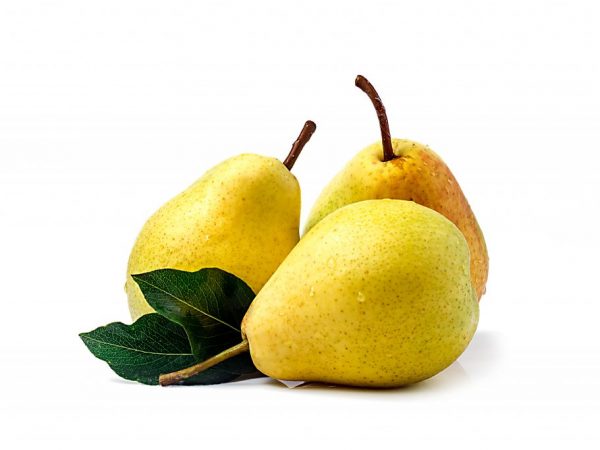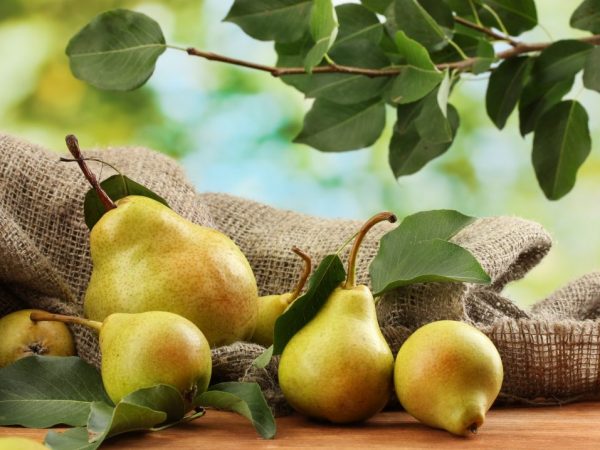Description of Pear Treasure
Despite the abundance of different fruit varieties, the Treasure pear is recognized all over the world. This high-yielding variety begins bearing fruit in the fall, allowing you to enjoy tasty and healthy fruits throughout the winter.

Description of Pear Treasure
Description of the variety
The Treasure pear variety was bred in Moldova by combining Olivier de Serres and Majestic Vienne rootstocks. Included in the State Register of Russia. Suitable for growing in all regions of the country, even the northern ones.
According to the description, the height of the tree is 2-2.2 m. The crown is wide and has a pyramidal shape. The stem is of medium thickness. The leaves of the pear of the Sokrovische variety are of a compact oval shape, covered with dense pubescence.
Features of the fetus:
- fruits are large, their length reaches 12-14 cm;
- the weight is 300 g: if the tree was developed on a quince rootstock, then the fruits can weigh up to 450 g;
- the stalk is small;
- the surface of the fruit is covered with small bumps;
- color - light green.
Taste and use
The peel is dense, the flesh is creamy. The juiciness of the pulp is high, which makes it possible to prepare juices from the fruits. The taste is pleasant, sweet. No acidity or bitterness observed.
This sort of pear is used in all directions: fresh, for preservation or preparation of various desserts.
Growing rules
Planting is carried out in early spring. The Treasure variety needs a lot of light, so for planting a seedling, you need to choose well-lit areas, without barriers or structures. The ideal soil that will increase yields is black soil or loamy soil. It is important that such a soil does not contain a large amount of alkali or acid (no more than 4%). Otherwise, when digging a site, you need to add 2 kg of lime for every 1 m2 of garden.
This pear variety is not self-fertile, therefore, to increase yields, you should plant Pet Clappa, Williams or Conference nearby.
You need to dig a small hole: 50 by 80 cm. Nutrient solutions are poured inside (20 mg of superphosphate or 30 g of potassium nitrate per 10 liters of water). After 14 days, the seedling can be planted. To do this, the roots are evenly distributed over the entire section of the hole and densely covered with earth. After that, pour 20 liters of warm water over the soil. Immediately after planting, you need to drive a metal rod next to it, which will become a support for the seedling.
Care advice

Pear is not picky
This variety needs standard care:
- Watering should be adjusted. It should be carried out every 1.5-2 weeks. At this point, 10-15 liters of warm water should be poured under each bush. It is best to irrigate the crop in the morning or evening so that the sun's rays do not evaporate moisture from the soil.
- Weed out the area and loosen the topsoil to remove the crust.
- Top dressing should be carried out for 2 years after planting in a permanent place. In the spring, at the end of March, a solution of phosphorus compounds (50 g of superphosphate per 10 l of water) should be added to the soil. With the onset of fruiting, a solution of ammonium nitrate is introduced (20 g per 10 l of water).In autumn, after harvesting, a dense layer of humus should be laid around the main tree trunk, which will protect the plant from frost.
- You need to prune branches in spring and autumn. In the spring, damaged and diseased branches are removed, which absorb many useful substances, due to which minimal fruiting occurs. In the fall, it is important to thin out the crown so that in the spring food flows into the inflorescences.
Pests and diseases
The description indicates that the Treasure pear species has an excellent immune system. The tree of this variety is not affected by powdery mildew, bacteriosis and fruit rot. The fruits are not affected by scab and moth.
The species does not need treatment procedures. It is important to carry out preventive measures that will protect the bush from parasites. For this, drip irrigation is used, which, falling on the leaves, washes away all bacteria and parasite larvae, even before the start of the incubation period.
Conclusion
Treasure is a type of pear tree that does not require a specific approach. Even beginners in the field of horticulture can take care of this crop without worrying about the quantity and quality of the crop.


